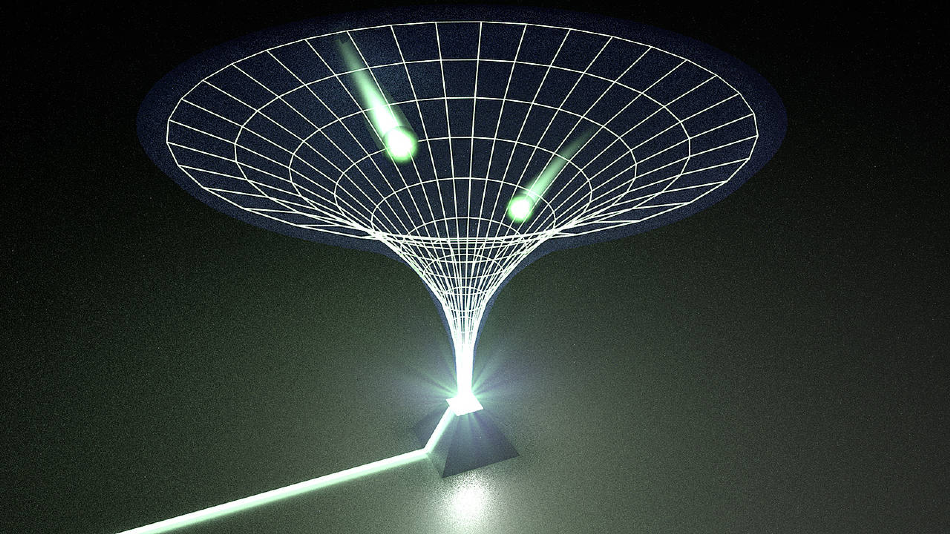Mar 30 2020
In association with researchers from the University of Rostock, physicists from the University of Würzburg have created a light funnel apparatus that could act as a novel platform for hypersensitive optical detectors.
 The figure shows how light is caught through the light funnel. Image Credit: Universität Rostock/Alexander Szameit.
The figure shows how light is caught through the light funnel. Image Credit: Universität Rostock/Alexander Szameit.
At the Julius-Maximilian University of Würzburg, Professor Ronny Thomale holds a chair for theoretical condensed matter physics, called the TP1. The main goal of his study is to find and hypothetically describe the novel quantum states of matter.
Developing a theory for a new physical phenomenon which then inspires new experiments seeking after this effect is one of the biggest moments in a theoretical physicist’s practice.
Dr Ronny Thomale, Professor and Chair of Theoretical Condensed Matter Physics, TP1, Julius-Maximilian University of Würzburg
In a perfect scenario, an effect like this would even reveal the unanticipated technological potential. This entire thing has come together with a new project that was pursued by Thomale along with the optical experimental team of Professor Alexander Szameit at the University of Rostock. The results of this project have recently been published in the Science magazine.
Spot Landing in an Optical Fiber 10 km of Length
“We have managed to realise an effect we call a‚ light funnel,” explained Thomale. Via this novel effect, light in an optical fiber measuring 10 km in length can be accrued at a desired particular point in the wire.
The so-called “non-Hermitian skin effect” is the mechanism that is fundamental to this phenomenon. In 2019, Thomale had contributed a valid theoretical work to this non-Hermitian skin effect. Thomale’s study has specifically facilitated the interpretation of the skin effect in the framework specified by topological states of matter.
Topological matter has emerged as one of the most exciting fields of research in modern physics. In Würzburg, Gottfried Landwehr and Klaus von Klitzing (Nobel laureate of 1985) have pioneered this field through their semiconductor research, which in the past 10 years, was upheld by Laurens W. Molenkamp.
Research on the Topology of Nature
The word “topology” comes from the old Greek words for “study” and “place.” Topology was mainly established as a mathematical discipline and it has now extensively spread into physics, such as optics. Along with various other platforms of synthetic matter, they form the wider direction called topological metamaterials of which the scientists anticipate important technological breakthroughs in the days to come.
In this analysis, the physicists did not fully resort to chemical compositions and materials provided by nature but instead, they created new artificial crystals made up of customized artificial degrees of freedom.
With respect to the light funnel created by Thomale and Szameit, the desired platform is an optical fiber that transmits light along the fiber, while simultaneously enabling in-depth spatially resolved manipulation.
Optical Detectors with High Sensitivity
The light accumulation achieved by the light funnel could be the basis for improving the sensitivity of optical detectors and thus enabling unprecedented optical applications.
Dr Ronny Thomale, Professor and Chair of Theoretical Condensed Matter Physics, TP1, Julius-Maximilian University of Würzburg
But the light funnel is just the beginning, according to Thomale. “Already at this stage we are working on many new ideas in the realm of topological photonics and their potential technological application,” he added.
To Thomale’s belief, the Julius-Maximilian University of Würzburg offers an excellent setting to pursue this direction of study.
Now, this has manifested itself in the excellence cluster “ct.qmat” which was jointly granted to TU Dresden and the JMU Würzburg. A major part of the “ct.qmat” study revolves around synthetic topological matter, which is robustly supported by the study performed at Thomale’s chair TP1 at the Julius-Maximilian University of Würzburg.
The research group at the University of Rostock around Alexander Szameit is constitutively incorporated into “ct.qmat.” For example, Thomale and Szameit mutually supervised PhD students who were financially supported via “ct.qmat.”
Already few months after its foundation, the synergies created by ct.qmat pay off, and demonstrate the stimulating impact of such excellence cluster on cutting edge research in Germany.
Dr Ronny Thomale, Professor and Chair of Theoretical Condensed Matter Physics, TP1, Julius-Maximilian University of Würzburg